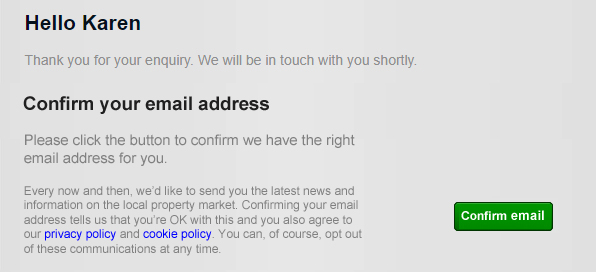The GDPR is an EU privacy law kicking into action on May 25th, 2018 with the goal of giving consumers more control over their personal data and its usage. After that date, any company which collects and processes the data of EU residents needs to be GDPR compliant. You can find out more about what this entails in our other guides.
As all estate agents collect personal data from their customers, it’s vital that you take steps to follow the new regulations. One of the most important areas to consider is your email marketing practices. Under GDPR, you will not be able to add customers to a mailing list without their consent or use their email address for any purpose other than the one they agreed on. For example, if a customer gets in touch via the contact form on your website but does not consent to receive marketing emails, you can only use their address for directly contacting them for transactional reasons – for example, setting up a viewing, or arranging a valuation. Breaches of the GDPR may incur tougher fines.
In this article, we’ll take a look at the benefits of using a double opt-in process for you and your customers, and how it relates to the GDPR.
What is a double opt-in and how does it relate to the GDPR?
A double opt-in introduces an extra step in the sign-up process. With a single opt-in, all a customer has to do to join your email list is enter their details into a sign-up form. Then they are immediately added to your list and start receiving emails from you.
With a double opt-in, a customer is not added to your email list until they have clearly given their consent. After entering their details, they receive an email asking them to confirm their subscription. Once they click a link in that email they are added to your list. If they never click the link, they should never receive emails from you.

The GDPR is all about consent. If you collect, process, store or in any way handle someone’s data, you need their permission. Equally vital, you need proof that they gave their permission. Consent needs to be active, not passive – no pre-ticked boxes or implied permission. At every stage, you need to use clear, unambiguous language to explain how you plan to use their data.
Double opt-ins perfectly meet those criteria. If you have evidence that a customer entered their details into a sign-up form, then clicked a link in their inbox, it’s hard for anyone to dispute that you had their consent.
Should there ever be any doubts about your compliance with GDPR, you need to be able to prove that the customer gave their consent.
What are the benefits of using double opt-in?
As many of your customers are likely to know about GDPR, a double opt-in process will show them that you respect their right to privacy and are committed to following all of the right regulations.
A double opt-in process will also improve the quality of your email list as you only contact those customers who are keen to hear from your business. You also remove misspelt or fake email addresses. So although your list may grow slower than before, you can expect higher open and click-through rates. This gives you a better sense of how your campaigns are working and more accurate results for A/B tests. If your engagement rates are currently lower than you’d expect, it may be the result of your opt-in process.
Plus, you won’t be paying your email provider for campaigns that bounce or have no chance of getting opened. Maintaining a large list can be extremely expensive – there’s no value to sending emails no one will receive.
Do I have to use a double opt in consent process if I have a Homeflow website?
You don’t need to use a double opt-in process to be GDPR compliant, but we believe it is the best option for both you and your customers.
If you’d like a quote for implementing an alternative consent process for your agency, please get in touch using the form below.
Should I implement a single opt-in marketing consent, or multiple consents?
We’re giving our website clients two options:
- Include a single marketing consent statement on their website forms – see this example.
- Set up multiple marketing consent statements – so that customers can opt in or out of different types of emails separately.
For the next article in this series, we’ll take a look at this choice in more detail.
Subscribe below to make sure you don’t miss out on the information you need to get ready for the GDPR.
Legal disclaimer: This article has not been prepared by a lawyer, and does not in any way constitute legal advice. This has been prepared to explain Homeflow’s current understanding of the implications of GDPR on our business, our clients and our services.